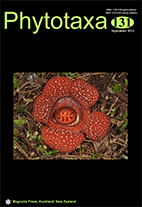Abstract
Coptis Salisbury (1807: 305) is a small genus of Ranunculaceae containing 10 (Ford 1997) to 15 (Fu 2001) species. It is distributed in temperate and boreal regions of East Asia and North America (Ford 1997, Fu 2001). In order to generate a comprehensive sampling for a phylogenetic reconstruction of the genus, we have reviewed all described species and their distribution (‘A synopsis of Coptis (Ranunculaceae)’, Li, unpublished). Accidentally, we identified a North American taxon, C. venosa Howell (1897: 21), that is not recognized by the latest updated Flora of North America (Ford 1997), nor has the name been included in any literature of the genus since its first description in the Flora of Northwest America (Howell 1897). Besides C. venosa, Howell (1897) recognized another four species from North America in his work: C. aspleniifolia Salisbury (1807: 306), C. laciniata Gray (1887: 297), C. occidentalis Torrey & Gray (1838: 28) and C. trifolia (Linnaeus 1753: 558) Salisbury (1807: 305), and commented that C. venosa was only collected by himself and has the same distribution range as C. occidentalis. No details were given about the morphological differences between C. venosa and the other four species. We closely examined protologues, descriptions, type specimens and other specimens of these five species. On the type specimen of C. venosa (deposited in Oregon State University Herbarium, OSC) (Fig. 1 A), we observed that the flowers of C. venosa are similar to those of C. aspleniifolia, C. laciniata and C. occidentalis in having linear-lanceolate sepals and petals, and nearly basal nectaries. Coptis venosa, however, is clearly different from C. aspleniifolia and C. occidentalis by having a biternate leaf blade that is almost identical to the leaf blade of C. laciniata. Based on overall similarity in morphology between C. venosa and C. laciniata, coupled with their overlapping distribution ranges, we hereby propose to treat C. venosa as a synonym of C. laciniata. Thus, we now recognize four species of Coptis in North America, C. aspleniifolia, C. laciniata, C. occidentalis and C. trifolia, and provide a key to identify them (as below).

